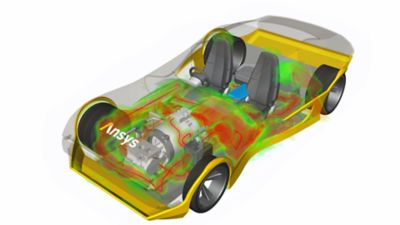-
United States -
United Kingdom -
India -
France -
Deutschland -
Italia -
日本 -
대한민국 -
中国 -
台灣
-
Ansys is committed to setting today's students up for success, by providing free simulation engineering software to students.
-
Ansys is committed to setting today's students up for success, by providing free simulation engineering software to students.
-
Ansys is committed to setting today's students up for success, by providing free simulation engineering software to students.
-
Contact Us -
Careers -
Students and Academic -
For United States and Canada
+1 844.462.6797
ANSYS BLOG
December 14, 2023
Advancing Automotive Trends: Electrification, Autonomy, Connectivity, and Artificial Intelligence
We’ve arrived at a major inflection point in the automotive industry. Everything we know about the journey from point A to point B is rapidly changing, punctuated by bursts of innovation. The road ahead is paved with exciting, yet unfamiliar, experiences. This article looks ahead to the trends that, enabled by simulation, will define our future mobility experiences — namely, electrification and autonomous vehicles, as well as the connectivity and artificial intelligence that supports their operation. It touches on the uncertainties and promise of these next-generation technologies, and simulation’s role in helping manufacturers and suppliers bring them to market faster.
Electrification
The debate over whether automotive is going electric or not is over. All major original equipment manufacturers (OEMS) have announced plans to go fully electric within the next decade or two. Of all the factors that play a role in this transition, the biggest one is cost. How do you reduce the cost of engineering, materials, and EV production? At the same time, how do you make the product more reliable?
It’s safe to say virtually everyone in the automotive space believes that digital engineering and digital innovation are the way to go. From specifications to systems validation, Ansys helps mobility innovators such as BMW, Porsche Motorsport, and Volkswagen evolve their electrification strategies.
“Digital engineering through simulation helps companies innovate faster, better, and cheaper — from initial design to simulation-driven product development,” says Dr. Zed Tang, technical account manager and subject matter expert on electrified powertrain at Ansys. “And, almost everyone is focused on using more simulation to help drive EV designs of the future.”

Electromagnetic simulation of an EV
Pushing the Boundaries of Efficiency
Within this new environment, OEMs and top-tier automotive suppliers face new challenges in pushing the boundaries of engineering design. Using an internal combustion engine as an example, improving overall efficiency by just one-tenth of a percent is significant to extending vehicle range. But at the end of the day, you could also just increase fuel tank capacity by one more gallon to achieve a similar result.
This is not the case for EVs, as adding one or more battery modules to a vehicle adds significantly more weight — which impacts more than just the battery pack design. It would also require the size of the electric motor to be adjusted and additional cooling for the electronics. Suddenly, the EV is heavier, and more of the battery’s energy is consumed. Now, companies must push the boundaries of EV design to reach maximum efficiency, because every bit of energy wasted can lead to a big disadvantage in the current market.
For this reason, engineers are doing whatever they can to push the boundaries of their design. If peak efficiency is 98%, everybody is trying to work out a way to develop something that is 98.1%.
“So, what does it mean to engineers working in the field?” asks Tang. “You can’t prototype enough or test enough to determine what that extra one-tenth of a percent is anymore. You have to dig deep, and how do you do that? You use simulation, because with simulation you can find out all of this. With some tweaks here and there with added automation and optimization, you can see results virtually and visually in a way that can help you understand much better how to extract that additional 0.1%.”

Electromagnetic simulation of an EV cable bundle
Autonomous Vehicles
We’re still many years away from riding around town in an autonomous vehicle — and most of us aren’t in a hurry to relinquish the steering wheel. In a recent survey conducted by the American Automobile Association, a majority of drivers favored improvements to driver assist systems already in place over the development of fully autonomous experiences. In fact, when asked, 85% said they were fearful or unsure of self-driving technology.1
However, automotive engineers continue to advance autonomous vehicle (AV) technologies to improve advanced driver assistance systems (ADAS) and to approach full autonomy further down the road. Unaffected by driver input, AVs offer transformative safety opportunities for all vehicle occupants (and the pedestrians they encounter during their travels). They also have the potential to make transportation more accessible and equitable for everyone, improve air quality, and, through thoughtful urban planning, reduce traffic congestion and create greener spaces.

Radar simulation of range and velocity of an AV and surrounding vehicles
Eliminating Human Error from the Safety Equation
“Essentially all the human factors you can think of that negatively influence driving would be reduced by the adoption of autonomous driving,” says Gilles Gallee, business developer and subject matter expert on autonomous vehicles at Ansys. “So, to put these risk factors behind us, we must be able to confidently state that autonomous driving is safer than a human driver before we can fully embrace self-driving vehicles. As we advance through various levels of autonomy, the key question for original equipment manufacturers is how to make the technology safer, and how to demonstrate that an AV is, in fact, safer than the human driver to the appropriate authorities.”
In the case of autonomous technology, OEMs cannot replicate safety performance through testing alone. This means OEMs must use safety of the intended functionality (SOTIF) scenarios that apply a certain methodology of testing to show the safety of their systems. SOTIF (ISO PAS/21448) was specifically developed to address autonomous and semi-autonomous vehicle safety challenges faced by vehicle software developers.
To overcome the huge effort required for safety validation, Ansys safety analysis software, in conjunction with the autonomy simulation toolchain, combines simulation at scale with statistics and scenario-based analysis. It also enables virtual sensor simulation for perception testing and sensor behavior validation in real-world scenarios for efficient reliability analysis.

Visual cameras and other sensors on AVs must be able to work safely in all kinds of weather, such as moderate rainy conditions.
To demonstrate these capabilities, Gallee’s team proposed that Mercedes should use Ansys design optimization tools in their demonstration of safety to German authorities. Their success using this method helped to make the Mercedes Benz 2022 S-Class the first L3 autonomous vehicle on the market worldwide.
Vehicle Connectivity and Artificial Intelligence
The future of autonomy could very well be driven by insights gained from the sharing of vehicle information connected via high-speed wireless networks. Several factors must be considered to reach high levels of autonomy, including advanced sensor technology, precise determinization of vehicle location, up-to-date mapping information, local perception of other vehicles and pedestrians, and planning and decision making.
To give you an idea of the magnitude of these interactions, in 2019, there were 31 million vehicles operating with some level of automation. By 2025, almost 60% of global new vehicle sales will function at level two (L2) autonomy.
Yet these achievements represent limited inroads to full autonomy. A huge computational task remains that will involve numerous in-vehicle applications requiring near real-time response. All this activity will be coordinated by artificial intelligence (AI) and a high level of connectivity supported by simulation at every turn — from safety validation to real-world sensor and antenna performance verification.
Vehicle Connectivity: The Bridge Between AI and AV
Of course, many conversations need to happen between an AV and other elements within a self-driving ecosystem that rely on consistent, low-latency connectivity to expand perception beyond what is directly in front of the vehicle.
“Fully autonomous environments of the future will all be dictated by a larger communication grid coordinating vehicle movement,” says Christophe Bianchi, Chief Technologist at Ansys. “The vehicle in the city talks to the city, talks to the other vehicles, and all of that involves a mission going from one place to another safely. So, how do you simulate all the events, everything that's happening in the environment, plus all the communication required, including the quality of signals between all these different parameters? That’s a mission for digital mission engineering software.”

AVs must be able to communicate with vehicles around them and with a city’s infrastructure through 5G connectivity.
We’re beginning to see some of these smart interactions play out now. Autotalks, a small apparatus that connects to the handlebar of your bicycle to avoid the risk of collision. This system connects to vehicles and related vehicle infrastructure as part of a broader mobility ecosystem, so that all vehicles, including bikes, will be connected and talking to the infrastructure and each other, monitoring traffic and sharing critical information in real time.
Reliable service and coverage are the most important success metrics that Autotalks, and other connected tech, will be measured by. Simulation enables 5G designers to achieve these objectives and increase product reliability while optimizing the power, performance, and cost.
Artificial Intelligence: The Brains of the Applications
AI relies on data, which is good for automotive because data-driven insights, coupled with machine learning (ML), have accelerated self-driving technology. One big challenge related to ADAS and autonomous applications is that AI/ML requires a massive dataset that covers all fringe corner cases and works in cohesion with rule-based systems to achieve better performance.
Ultimately, it’s through AI/ML-driven decision-making systems working closely with rule-based systems for AVs that the complexity of operating safely within a real driving environment is prioritized for safety. AI/ML systems can calculate the risk scores for any driver maneuver, giving them the necessary control to make a decision.
“In automotive AI/ML, one of the critical challenges is that the discovery of those rules becomes a hard problem when the data is not covering the entire space correctly,” says Jay Pathak, Senior Director of Research and Development at Ansys. “On the road, multiple factors are in play, and the dataset coming out of any on-road interactions is a reflection of all these environmental factors happening together; whereas, to discover all of them independent of each other, we simply don’t have the data. This presents a big challenge in the automotive machine learning community.”
Obtaining the necessary data will involve a shift away from big data to useful data, as well as unsupervised AI learning methods augmented by simulations, to create challenging dynamics in datasets which otherwise will be difficult to find in real situations. Just as AI applications have “read” the whole internet to learn how words fit together well enough to write credible essays, AI applications in autonomous driving will absorb all the data from innumerable driving simulations to better inform autonomous control software of how to react in any driving situation.
Accelerating electrified and autonomous driving to meet current industry trends demands extraordinary solutions. Behind nearly every on-road communication and every cloud-based data exchange is a corresponding Ansys solution. Mobility leaders are benefitting from a vast portfolio of Ansys simulation and software-related tools to drive the next wave of vehicle tech.
Learn how Ansys can help with your automotive applications.
References
- AAA Survey Reaffirms Public Skepticism Over Self-Driving Tech, IoT World Today, May 20, 2022.











